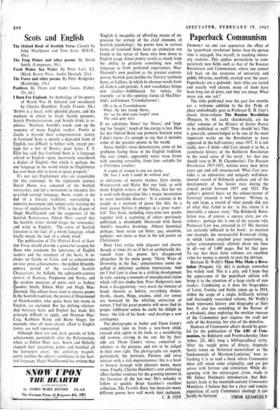Paperback Communism
PROBABLY no one can appreciate the effect of the 'paperback revolution' better than the person Who is engaged, like myself, in teaching univer- sity students. This applies particularly to com- paratively new fields- such as that of the Russian Revolution and Communism, where one cannot fall back on the resources of university and public libraries, carefully stocked over the years. Paperbacks are a godsend: their titles are varied and usually well chosen, many of them have been long out of print, and they are cheap. What more can one ask?
The titles published over the past few months -are a welcome addition to the list. Pride of place undoubtedly goes to Professor E. H. Carr's classic three-volume The Russian Revolution (Penguin, 9s. 6d. each). (Incidentally, are the other volumes of his History of Soviet Russia to be published as well? They should be.) This is generally acknowledged to be one of the most important works on the Revolution to have ,appeared in the half-century since 1917. It is not 'really, nor—I think—did Carr intend it to be, a systematic history of the Bolshevik Revolution in the usual sense of the word: for that one should turn to W. H. Chamberlin's The Russian Revolution 1917-1921, written more than thirty years ago and still unsurpassed. What Carr pro- vides is an exhaustive and uniquely, well-docu- mented record of Bolshevik policies and of the development of the Soviet state during the crucial period between 1917 and 1923. The author's general thesis on the subject-matter of historical research is well known: 'History is, by and large, a record of what people did, not of what they failed to do: to this extent it is inevitably a success story.' The Bolshevik Revo- lution was, of course, a success story par ex- cellence: perhaps this is one of the reasons why Professor Carr was attracted to it? His theories are certainly reflected in his book : to mention one example, the unsuccessful Kronstadt rising, to which Lenin attached great importance, is rather contemptuously allotted about ten lines in all—out of 1,400 pages. But let that pass. To say that these three volumes are excellent value for money is merely to state the obvious.
Bertram D. Wolfe's Three Who Made a Revo- lution (Penguin, I2s. 6d.) is perhaps somewhat less widely read. This is a pity, and I hope that the appearance of the paperback edition will bring it to the attention of a large circle of new readers. Combining as it does the biographies of Lenin, Trotsky and Stalin, taken up to 1914, within the scope of a single, brilliantly written 'and thoroughly researched volume, Mr Wolfe's book represents history and biography at their best. It also has something of the flavour of a whodunit, since exploring the murkier recesses of the Communist past requires the craft not only of the historian, but also of the detective.
Students of Communist affairs should be grate- ful for the publication of The ABC of Com- munism, by Bukharin and Preobrazhensky (Ann Arbor, 22s. 6d.), long a bibliographical rarity. 'After the turgid prose of dreary, dogmatic Soviet tomes on 'historical materialism' or 'the 'fundamentals of Marxism-Leninism,' how re- ''freshing it is to read a book where Communist ideas still retain some originality, and are put across with fervour and conviction. While dis- agreeing with the extravagant claim, made in Mr Sidney Heitman's introduction, that Buk- harin's book is the twentieth-century Communist 'Manifesto, I believe that for a,clear and concise exposition of early Communist ideology it can





























 Previous page
Previous page